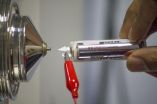(Press-News.org) BOSTON–While the Food and Drug Administration (FDA) has released guidelines for the regulation of mobile health (mHealth) apps that act as medical devices or as accessories to medical devices, the vast majority of mHealth apps remain unregulated and unevaluated. In a Viewpoint article, "In Search of a Few Good Apps", published in JAMA on March 24, 214, co-authors, David Bates, MD and Adam Landman, MD of Brigham and Women's Hospital (BWH) and Adam Powell, PhD, president of Payer+Provider Syndicate, call for the creation of mHealth (mobile health) app review and certification organizations to evaluate apps that are not regulated by the government.
"This article gives health care providers, patients, policymakers and mHealth app developers a perspective on how the issue of determining which apps are most useful might be addressed," said Bates, who is Chief Quality Officer at BWH and chaired the Food and Drug Administration Safety and Innovation Act (FDASIA) Workgroup that made recommendations to the government about regulation of HIT and mobile apps. "Establishing an unbiased review and certification process is a key step in helping mHealth apps achieve their potential."
The concept for this Viewpoint article was conceived by Landman and Powell after discussing their mutual concern about the lack of oversight over the accuracy, quality, and security of mHealth apps at the BWH Hackathon, an event sponsored by BWH's Innovation Hub (iHub).
"Dr. Powell and I examined numerous mHealth apps and it was difficult to assess app credibility," said Landman, Chief Medical Information Officer for Health Information Innovation and Integration and an emergency medicine physician at BWH. "The currently available reviews of mHealth apps have largely focused on personal impressions, rather than evidence-based, unbiased assessments of clinical performance and data security. With more rigorous certification criteria and unbiased accrediting bodies, both clinicians and consumers could be more confident in their selection and use of mHealth apps."
In the article, authors describe the potential for multiple organizations to be created that could review and objectively certify mHealth apps for quality, accuracy, security and safety, similar to the role that Health On the Net Foundation (HON), a non-profit, non-governmental organization, plays in evaluating the quality of online medical content.
"People are increasingly turning to their smartphones for assistance in improving their health, but are having difficulty determining which apps are the securest and most effective. We hope that our article will instigate action that will enable clinicians and patients to make more effective use of mHealth apps," said Powell, lead author of the article. "We foresee a potential future in which physicians will be able to confidently prescribe apps to their patient, and will have the tools that they need to interpret the resulting data. The establishment of an unbiased app certification and review process will play a key role in getting us there."
INFORMATION:
Brigham and Women's Hospital (BWH) is a 793-bed nonprofit teaching affiliate of Harvard Medical School and a founding member of Partners HealthCare. BWH has more than 3.5 million annual patient visits, is the largest birthing center in New England and employs nearly 15,000 people. The Brigham's medical preeminence dates back to 1832, and today that rich history in clinical care is coupled with its national leadership in patient care, quality improvement and patient safety initiatives, and its dedication to research, innovation, community engagement and educating and training the next generation of health care professionals. Through investigation and discovery conducted at its Biomedical Research Institute (BRI), BWH is an international leader in basic, clinical and translational research on human diseases, more than 1,000 physician-investigators and renowned biomedical scientists and faculty supported by nearly $650 million in funding. For the last 25 years, BWH ranked second in research funding from the National Institutes of Health (NIH) among independent hospitals. BWH continually pushes the boundaries of medicine, including building on its legacy in transplantation by performing a partial face transplant in 2009 and the nation's first full face transplant in 2011. BWH is also home to major landmark epidemiologic population studies, including the Nurses' and Physicians' Health Studies and the Women's Health Initiative. For more information, resources and to follow us on social media, please visit BWH's online newsroom.
In search of a few good apps
New JAMA article suggests review and certification process for mHealth apps
2014-03-25
ELSE PRESS RELEASES FROM THIS DATE:
Study: Salamanders shrinking due to climate change
2014-03-25
Wild salamanders living in some of North America's best salamander habitat are getting smaller as their surroundings get warmer and drier, forcing them to burn more energy in a changing climate.
That's the key finding of a new study co-authored by a Clemson University biologist and published Tuesday in the journal Global Change Biology that examined museum specimens caught in the Appalachian Mountains from 1957 to 2007 and wild salamanders measured at the same sites in 2011-2012.
The salamanders studied from 1980 onward were, on average, eight percent smaller than their ...
Nanotube coating helps shrink mass spectrometers
2014-03-25
WEST LAFAYETTE, Ind. — Nanotechnology is advancing tools likened to Star Trek's "tricorder" that perform on-the-spot chemical analysis for a range of applications including medical testing, explosives detection and food safety.
Researchers found that when paper used to collect a sample was coated with carbon nanotubes, the voltage required was 1,000 times reduced, the signal was sharpened and the equipment was able to capture far more delicate molecules.
A team of researchers from Purdue University and the Indian Institute of Technology Madras performed the study, which ...
Model predicts blood glucose levels 30 minutes later
2014-03-25
A mathematical model created by Penn State researchers can predict with more than 90 percent accuracy the blood glucose levels of individuals with type 1 diabetes up to 30 minutes in advance of imminent changes in their levels -- plenty of time to take preventative action.
"Many people with type 1 diabetes use continuous glucose monitors, which examine the fluid underneath the skin," said Peter Molenaar, Distinguished Professor of Human Development and Family Studies and of psychology. "But the glucose levels under the skin trail blood glucose levels from anywhere between ...
NASA satellite sees wind shear whipping Tropical Cyclone Gillian
2014-03-25
A visible image from NASA's Aqua satellite provides a clear picture that wind shear is responsible for weakening the once mighty Tropical Cyclone Gillian from hurricane to tropical storm strength.
When NASA's Aqua satellite flew over Gillian on March 25 at 06:30 UTC/2:30 a.m. EDT, the Moderate Resolution Imaging Spectroradiometer or MODIS instrument took a visible picture of the storm. That image showed that wind shear has pushed clouds and showers away from the center as the storm weakened to a tropical storm.
In the MODIS image, the center of Gillian's circulation ...
Haynes is first to identify cellular patterns of contraction in human hearts
2014-03-25
LEXINGTON, Ky. (March 19, 2014) — When Premi Haynes was growing up in Pune, India, she attended Stella Maris High School, an English language convent school founded by Swiss nuns. Her second grade singing class used a book of English songs. One of the songs was "My Old Kentucky Home." At that time, Haynes had never heard of Kentucky, had no idea where it was, and had no particular ambition to go there.
Some 20 years and a twist of fate later, on March 19 Haynes successfully defended her Ph.D. thesis in physiology at the University of Kentucky, where she's made a significant ...
Agricultural fires across Sierra Leone
2014-03-25
Marked in red, hundreds of land use fires burn in the fields across Sierra Leone. Most fires in this region are deliberately set for a variety of reasons, including slash and burn agriculture. When a plot of land becomes exhausted, farmers shift cultivation to another plot where they cut the trees and brush at the beginning of the dry season in January and February. Once the dead plant material has dried, they set fire to it. Such fires peak in March and April right before farming season begins.
From space, MODIS detects thermal anomalies, including fires, flares, and ...
Sensing gravity with acid
2014-03-25
WOODS HOLE, Mass.—While probing how organisms sense gravity and acceleration, scientists at the Marine Biological Laboratory (MBL) and the University of Utah uncovered evidence that acid (proton concentration) plays a key role in communication between neurons. The surprising discovery is reported this week in Proceedings of the National Academy of Sciences.
The team, led by the late MBL senior scientist Stephen M. Highstein, discovered that sensory cells in the inner ear continuously transmit information on orientation of the head relative to gravity and low-frequency ...
Understanding plant-soil interaction could lead to new ways to combat weeds
2014-03-25
URBANA, Ill. – Using high-powered DNA-based tools, a recent study at the University of Illinois identified soil microbes that negatively affect ragweed and provided a new understanding of the complex relationships going on beneath the soil surface between plants and microorganisms.
"Plant scientists have been studying plant-soil feedback for decades," said U of I microbial ecologist Tony Yannarell. "Some microbes are famous for their ability to change the soil, such as the microbes that are associated with legumes—we knew about those bacteria. But now we have the ability ...
Patient safety merits new review for modified medical devices, physician says
2014-03-25
For patient safety, the U.S. Food and Drug Administration (FDA) should require that clinical data be submitted as part of a more rigorous re-evaluation of medical devices that are modified after approval, according to UC San Francisco physician scientists in a commentary published online March 24, 2014 in the Annals of Internal Medicine. According to authors Rita Redberg, MD, UCSF professor of medicine, and UCSF second-year medical student Sarah Zheng, such a requirement could prevent deaths due to insufficiently tested device modifications.
"The need for rapid approval ...
USF study: Blood-brain barrier repair after stroke may prevent chronic brain deficits
2014-03-25
TAMPA, Fla. (March 25, 2014) – Following ischemic stroke, the integrity of the blood-brain barrier (BBB), which prevents harmful substances such as inflammatory molecules from entering the brain, can be impaired in cerebral areas distant from initial ischemic insult. This disruptive condition, known as diaschisis, can lead to chronic post-stroke deficits, University of South Florida researchers report.
In experiments using laboratory rats modeling ischemic stroke, USF investigators studied the consequences of the compromised BBB at the chronic post-stroke stage. Their ...
LAST 30 PRESS RELEASES:
New fossil study illuminates on the evolutionary success of frogs
Patient-specific human liver model to understand disease mechanisms
Confused by the doctor's questionnaire? U of A study suggests it's common
How do brains stay stable, and when might a dose of flexibility be helpful?
mRNA revitalizes aging immune systems—the liver as a fountain of youth
Rural-urban differences in the prevalence of chronic pain among adult cancer survivors
Food insecurity, burnout, and social isolation among resident and fellow physicians
How do spinal cord injuries heal?
Detailed cell map unlocks secrets of how reproductive organs form
Large language models unleash AI’s potential for autonomous and explainable materials discovery
Gut bacteria have evolved rapidly to digest starches in ultra-processed foods
New risk score helps predict pancreatic cancer recurrence
New evidence challenges understanding of Parkinson’s disease
A new study reveals how embryos and the uterus “talk” during implantation
Cedars-Sinai reports heart attacks, general illness spiked after LA fires
PolyU develops ultra-stable, mucus-inspired hydrogel to boost gastrointestinal wound healing
Flour choice shapes sourdough microbial communities
Can a retinal implant reverse macular degeneration?
Feeding fungi plant remnants produces tasty protein to fortify vegan, vegetarian diets
New tech reduces false positives from breast ultrasounds
Drone-mounted lab monitors fertilizer runoff in real time
Short, light-intensity exercise boosts executive function and elevates mood in children
Jeonbuk National University researchers reveal new interface engineering strategy for efficient and stable back-contact solar cells
Tyrosinase drives hydroquinone-induced exogenous ochronosis: not HGD inhibition
UMass Amherst chemists develop unique tool for studying RNA
Disappointment alters brain chemistry and behavior
A built-in odometer: new study reveals how the brain measures distance
Stress-related brain signals drive risk of cardiovascular disease in people with depression and anxiety
New details on role of fat transport molecules in Alzheimer’s onset
Study illuminates how an antiviral defense mechanism may lead to Alzheimer’s disease
[Press-News.org] In search of a few good appsNew JAMA article suggests review and certification process for mHealth apps






